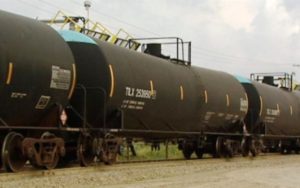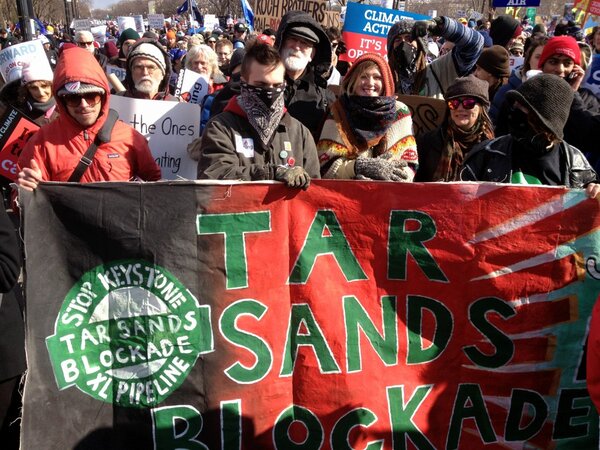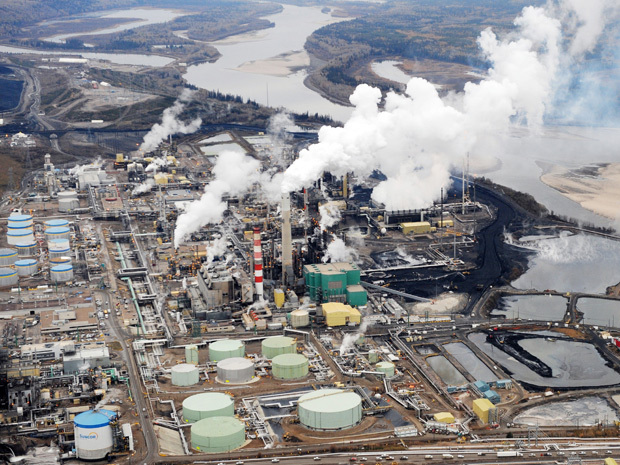When it comes to the flow of northern crude to U.S. refineries, here’s the reality: No Keystone XL [tar sands oil pipeline]? No problem. – Robert Bryce in Slate.com
A Direct Response to Robert Bryce’s Op-Ed in Slate.com
By Peter Jefferson Nichols
Josh Fox, the creator of the whistle-blowing documentary that made flaming faucets famous, “GasLand,” made a sequel short film called “The Sky is Pink.” In it he chronicles the difference between “investigative” journalism and “he said/she said” journalism. It is available for your viewing pleasure here. http://vimeo.com/44367635
Inspired, I’ve decided to textually mimic his process. I will respond as directly and as frequently as possible to writing that I find dangerously, willfully misleading.
Dear Robert Bryce,
I read your article in Slate, “Is the Keystone XL Pipeline Worth Getting Arrested For?”, and I’ve got some remarks in response.
To start with, a compliment: Way to be forward thinking! The KXL pipe is in danger of not receiving the required executive permit. Why? Well because TransCanada seems to have developed a nasty habit of shooting themselves in the corporate personhood foot.
- Their 2010-constructed Keystone 1 pipeline, which starts in Hardisty, Alberta and ends in Cushing, Oklahoma, failed, meaning spilled heavy crude, 12 times in its first year of operation. They had predicted an “incident” due to corrosion once every 3,400 years and an “incident” due to flooding once every 87,800 years. Their insurance rates should be skyrocketing.
- While the Governor of Nebraska rescinded his objection to the KXL bisecting his state, a story broke that the company hired to conduct an environmental impact report of the proposed pipe was in bed, to the tune of $1.2 billion, with TransCanada. Spokespersons were reportedly overheard whispering, “Listen sweetheart, I’ll rub your back if you rub mine.”
- On December 3, 2012 Isabelle Brooks was sleeping inside a section of yet to be laid pipe in Eastern Texas. It was a part of the extension to Keystone 1, endorsed by our intrepid P.O.T.U.S. on March 22, 2012 and under construction since August 16, 2012. She was participating in an act of civil disobedience in concert with the Tar Sands Blockade and resting before the inevitable arrival of policy enforcers. She woke up because sunlight was striking her eyelids. She looked up to see an egregiously defective weld. She took pictures. Later that day she was arrested, along with two others, and then held in jail on $65,000 bail for just under a month. Later that day the segment of pipe she had been in was buried. It now lies well within a stone’s throw of a swing set in the back yard of a private residence.
No Keystone, No Revenue for the Tar Sands Industry

“The Keystone XL is designed to transport 830,000 barrels per day.”
“In December, U.S. and Canadian railroads were hauling about 1.9 million barrels of oil and refined products per day.”
“Over the past two years or so, domestic railroads have increased their transport capacity by an amount equal to about 55 percent of what Keystone is supposed to provide.” — Robert Bryce
Now, I’m not a seasoned financial expert, I’m pursuing a M.F.A. in poetry and I just learned the word fungible, which has surprisingly little to do with psilocybin, but if 830,000 barrels per day (bpd) are prevented from flowing through a pipe, and if it took the past 2 years for domestic railroads to increase their capacity (is this statistic specific to tar sands?) to half that of the proposed pipe, wouldn’t it take 4 more years for them to achieve the total carrying capacity that they had accounted for by assuming the pipe would get rubber stamped? They had to have believed that the bitumen would flow by both rail and pipe, not by one or the other. So if by stopping the pipe, the Tar Sands Industry is set back four years isn’t that a BIG PROBLEM FOR THEM? WOULDN’T THAT ROYALLY PISS OFF THEIR INVESTERS? How much lost revenue is 830,000 bpd * 365 days * 4 years? In my lay man / poetic terms, I’d say “that’s a FUCK-TON of lost revenue.”
The Business of Rail-Delivered Crude
Moving on, you give various examples of refineries increasing their capacities to process rail-delivered crude.
“Sandy Fielden, an analyst for energy consulting firm RBN Energy LLC, reported that about 1 million barrels per day of new rail-unloading capacity is being built or planned in the United States.”
“Rusty Braziel, RBN’s president, told me that the surge in moving oil by rail will continue.” — Robert Bryce
Mr. Bryce, you said that rail offers “oil producers” advantages, specifically “optionality,” that pipelines cannot provide. Trains can go more places than pipes, is the assumption. Have you seen this map of proposed pipelines? Also touted is the fact that “oil producers often have to make a commitment to ship their product on a given pipe for 10 or even 20 years…the railroads will build a terminal for an 18-36 month commitment.” Well those numbers smell funny. Why have to commit to 20 years? Because this ain’t your grandpappy’s sweet, light crude we’re talking about here. Those numbers smell like sulfur.
Learn the difference between heavy and light, sweet and sour crude.
Do you follow Enbridge on Twitter? I do and that led me to this pdf.
“Any additional capacity for Canadian oil would require refinery modification or additional refineries, both of which are not expected given the volume of lighter and more valuable crude from the Middle East finding its way to (Pacific Basin) markets…Consequently, any new refinery capacity is not likely to be dedicated to Canadian crude shipments. This places increasing importance on the need to enter into long term contracts to supply (Pacific Basin) refineries, backed up by evidence of adequate transportation capacity.” — University of Calgary School of Public Policy
Those modifications are not cheap, they cost billions of dollars, so absent commitments from both the supply and market sides of the economy, it is highly unlikely that they will be implemented in a wide enough range of locations so as to make “optionality” an advantage; in fact it seems that “optionality” is more of a liability to the dissemination of Western Canadian Crude, than an advantage.
Tar Sands Passage to Alaska: No Problem?
I continued to read your article… and nearly suffered a stress induced aneurysm when I passed my eyes over “a group of Canadian businessmen is aiming to build a huge rail project that could haul 5 million barrels of crude per day northwest from Fort McMurray, Alberta, to Valdez, Alaska, where it could be loaded onto supertankers. The proposal has reportedly received approval from native tribes in Alaska and Canada and could begin operating as soon as 2018.” That approval, the link explains, was reported by Generating for 7 Generations CEO Matt Vickers. He claimed the unanimous support of the National Assembly of First Nations…dubious. Have you not heard of Idle No More? Did you not hear of Chief Theresa Spence’s 44-day hunger strike? How about The Unis’tot’en? The Beaver Lake Cree? They are not just against transportation by any means, but extraction at any level. Do you know what it takes to make tar sands, normally the consistency of peanut butter, flow through a tube? Here is a fun instructional video from the friendly motherfuckers at Canadian Natural.
Pro-tip: when doing research and using Google, drop the “search tools” tab, click “any time” and select “past month.” Doing just that got me to this article published by the fine folks at the Alaska Dispatch on Jan 6, 2013, which refutes the notion that rail is a sound way of shipping oil. “Operational costs are way higher for a railway…more labor, fuel, equipment are required…That is why pipelines exist.” No Problem? More like BIG PROBLEM!
Tar Sands Blockade: From Politics, to Organizing, to Peaceful Civil Disobedience
In parting, another compliment: “Blocking a pipeline, isn’t the same as blocking the flow of oil.” Hell yeah it ain’t! Diversity of targets! Diversity of tactics! If I am going to stop the single most profitable and destructive commodity on the planet from permanently spoiling our finite commons, the market place, I’ve got to do more than merely hold rallies and get arrested. I’ve got to organize. And that’s exactly what I’m doing, along with my siblings in solidarity. And you know what? We are seeing results. That’s why just under 50 thousand of us gathered on a cold February day in D.C. last week. Not to hear speeches, though they were eloquent, but to make contacts. That’s exactly why I was at the Power Up Divestment Fossil Fuels Convergence at Swarthmore College this past weekend. And its exactly why I am optimistic that while now we can hope for little but “symbolic victories” (the folks in Texas watching a trench get dug in their back yards or suffering from inhaling toxins belched by refineries would strongly object to being called “symbolic,”) someday soon we will start notching our belts with “real victories.” That will happen when we reattach our currency to a commodity and get that currency out of our politics. Thankfully, I know folks trying to do just that: 99 Rise!
See you on the playground,
Peter Jefferson Nichols
P.S.
I know that space limits the scope of any argument, but can you really tell the story without including any reference to popular science? Are you a Justin Bieber fan? This past summer Rolling Stone magazine published an issue with Bieber-Cakes on the cover. An article inside titled Global Warming’s Terrifying New Math and written by Bill McKibben contextualizes three numbers, 565, 2 and 2,795. The article got over 125,000 likes on the helping friendly Facebook. If you haven’t read it, drop what you are doing now and hyperlink away.
P.P.S. “Oil pipeline opponents may target rail shipments next.”
P.P.P.S. And this:
httpvh://youtu.be/EMTdOIJt-Sc
Canadian Pacific Railway is responsible for a 30,000 gallon Tar Sands Oil spill in Western MN, after a train derailment at the end of March.















Pingback: Sorry Slate, No Keystone, Big Problem for Tar Sands - LA Progressive
oh, this is good:
http://www.youtube.com/watch?v=EMTdOIJt-Sc&feature=youtu.be